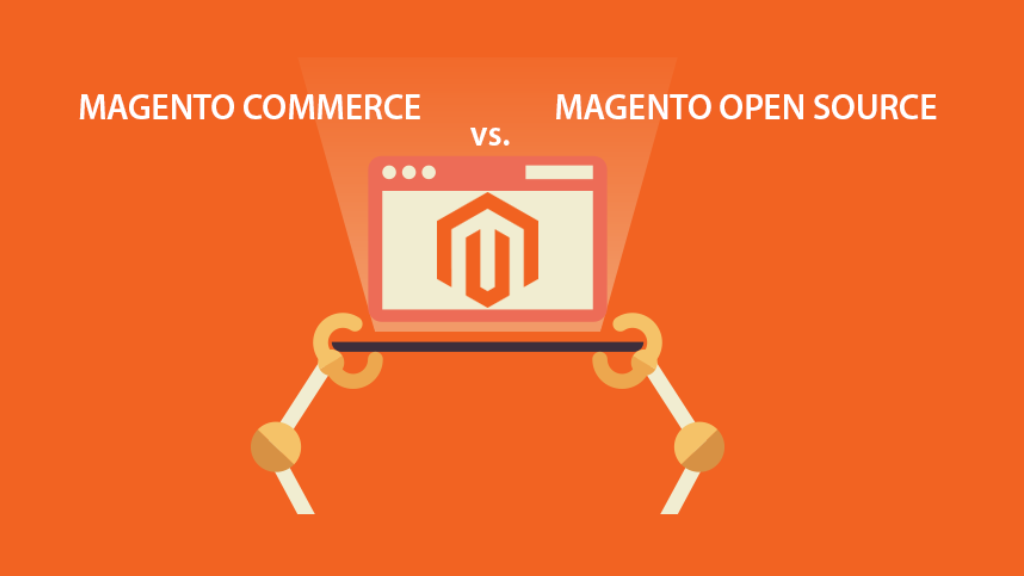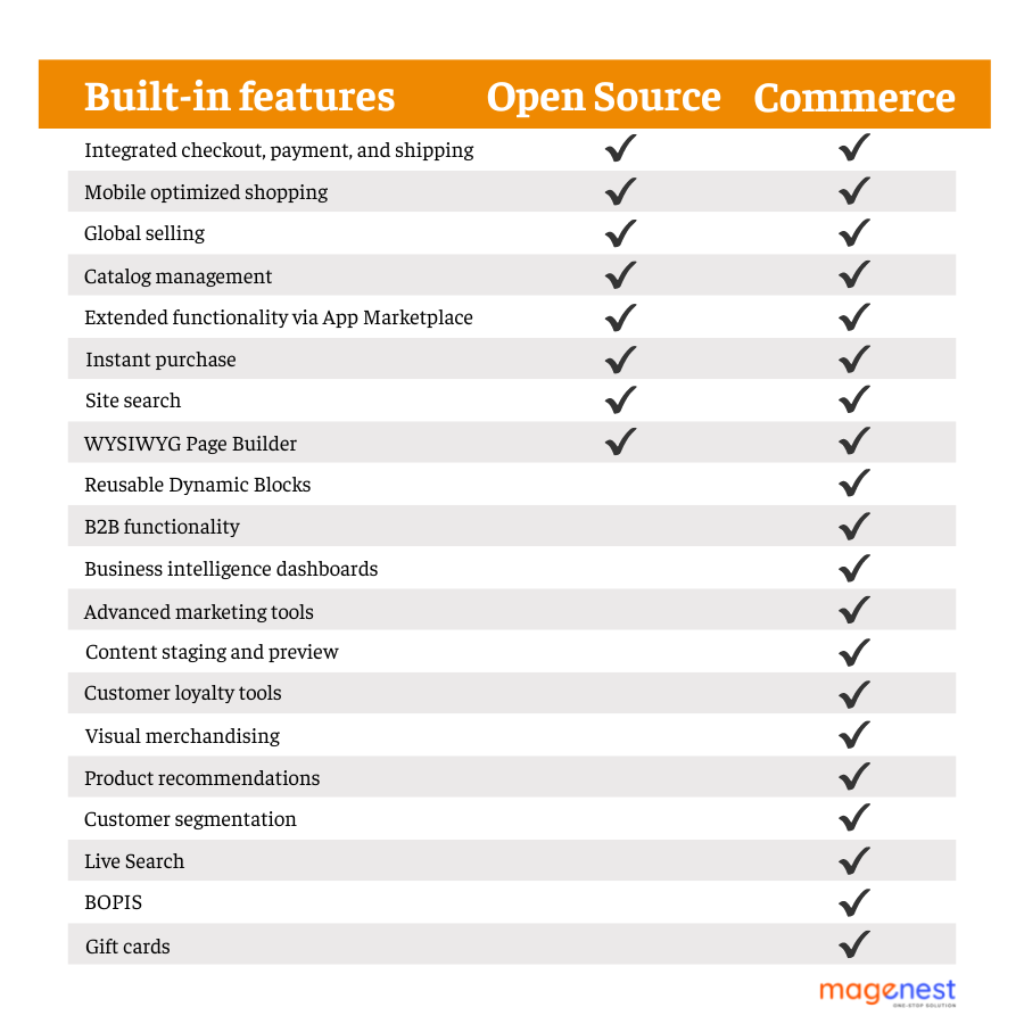Released in 2008, Magento is now considered one of the most widely-recognized platforms in the eCommerce market. It has been chosen by more than 250,000 businesses worldwide, ranging from single-store owners to large multinational corporations such as Coca-Cola, Samsung, Nike, etc. For any business owners that are considering Magento as the next platform to power their sites, there are some important decisions needed to be made. Among them, the big one is between Magento Open Source vs Magento Commerce, which version is better to opt for? If you are also having the same question, let’s read over our article and find out the answer.
Table of Contents
Magento Open Source vs Commerce, the Basic Knowledge
What Is Magento?
Magento is an open-source eCommerce platform written in PHP, helping customers quickly create an eCommerce website with all the necessary functions. This platform was first developed by Varien Inc., in 2007 based on Zen Framework and has soon gained a surge in popularity.

Magento currently offers two versions: Magento Open Source and Magento Commerce. So what are the differences between Magento Commerce vs Magento Open Source?
Magento Open Source
Magento Open Source was originally called Magento Community Edition (or CE), the free version of Magento. In 2017, the Magento Community Edition was renamed Magento Open-source and this name has remained until now. Magento Open Source can be downloaded and used for free and has long been a popular choice for Small and Medium businesses who want a platform that is feature-rich, highly extensible, and can compete with big names.
Magento Commerce
Magento Commerce was formerly known as Magento Enterprise Edition (EE). This release is aimed at larger businesses that require high-quality service and a broader set of functions. While Magento Open Source is free, Magento Commerce is a paid version that gives customers the ability to choose between on-premise deployment and a cloud-hosted solution. The two options are primarily the same, but there are some additional features in the Commerce Cloud solution that set it apart from Magento Commerce On-premise and Magento Open Source platforms.
What Different Technologies Are Used in Magento Commerce vs Open Source?
Magento Commerce vs Magento Open Source is kind of similar in terms of technology, with the most important elements of the Magento 2 technology stack including:
- PHP
Magento 2 requires PHP 5.5 and 5.6 by default. Besides, it will also work with PHP 7. The new version of PHP helps fasten the loading of the platform greatly and simplifies a coding routine significantly.
- Zend Framework
Magento 2 uses different frameworks including Zend Framework 1, Zend Framework 2, Symfony, etc. Instead of directly relying on ZF 1, it utilizes its own adapters and interfaces used for tunneling calls to ZF 1 components. Users are encouraged to use the official Magento framework APIs to avoid encountering issues related to the platform’s internal changes.
- PSR
The coding standards included in the Magento 2 technology stack are PSR-0, 1, 2, 3, and 4. PSR-0 is the default autoloading standard, PSR-1 is a set of basic coding standards, and PSR-2 is a coding style guide. PSR-4 is recommended as a replacement for PSR-0 since it has been marked as deprecated. As for PSR-3, it defines a logger interface that enables users to write reusable code independent from any particular logging implementation.
- Composer
The composer brings in a dependency management package for PHP. It is among the key system requirements of the Magento platform.
- HTML5
HTML5 is a markup language used for structuring and presenting front-end components in Magento 2. It helps simplify development and is a vital Magento 2 technology stack component.
- CSS3
Magento 2 uses LESS and CSS in the theme core. LESS preprocessor and LESS PHP adapter allow using LESS within the platform. In its turn, the CSS URL resolver resolves links from CSS source files and replaces them with the correct ones.
- JQuery
Magento 2 incorporates a fast, lightweight, and feature-rich Jquery by default. JQuery was designed to simplify DOM manipulation and has become one of the most popular JavaScript frameworks today.
- RequireJS
Another noteworthy component related to JavaScript in the Magento 2 technology stack is RequireJS. As a file and module loader optimized for in-browser use, RequireJS significantly enhances the speed and quality of your code.
- Symfony
Symphony is a PHP framework and a set of reusable PHP components, helping speed up your custom Magento development services by providing the ability to avoid repetitive coding tasks.
- Apache
Magento 2 requires Apache 2.2.x or 2.4.x. This web server is the most popular in the world (used by 60% of all websites), and now it is officially a part of the Magento 2 technology stack.
- Nginx
Nginx is the reverse proxy server that is gaining more and more popularity due to its low memory usage and high performance. When installed in Magento, Nginx helps facilitate multiple protocols, like HTTPS, HTTP cache, POP3, and IMAP.
- MySQL
MySQL is a database management system. When incorporated in Magento, it helps to save time and money powering high-volume projects. The platform uses MySQL database triggers to improve database access during reindexing.
- Twig
Twig is a fast, flexible, and secure PHP template engine. It is now supported by Magento 2 to help users simplify their work with themes and templates.
Magento Open Source vs Commerce Comparison
The difference between Magento Open Source vs Commerce lies in two main areas: Pricing and Features.
Pricing
The major difference between Magento Open Source vs Commerce is the cost. As mentioned earlier, there are two options for Magento implementation, the free-of-charge option – Magento Open Source; and the paid option – Magento Commerce.

Magento Open Source is widely chosen by small and medium-sized businesses as its source code is freely available. Users can customize it to create functionalities whenever they need. Though the Open Source platform is free, companies still need to invest money in hiring developers to help them set up their Magento sites. This will add up to the total cost of a Magento implementation project, but the Open Source version’s pricing is still the most approachable and affordable out there.
Magento Commerce is specially designed for large-sized companies with mission-critical websites that are processing hundreds or thousands of transactions every day. Magento Commerce pricing varies between two options, Magento Enterprise and Magento Enterprise Cloud:
- Magento 2 Enterprise Solutions: Price ranges from $22,000 to $125,000.
- Magento Enterprise Cloud Solutions: Price ranges from $40,000 to $190,000.
It’s true that you get what you pay for. Though Magento Commerce is not affordable for all companies of any size, it is no doubt very attractive for big corporations thanks to its unrivaled feature set. So choose wisely between Magento Open Source vs Magento Commerce based on your organization’s size and needs.
Features
First, let’s have a look at the overview picture describing Magento Commerce vs Magento Open Source feature list.

Now, we’ll go into more detail about some significant features:
Implementation and installation
The time frame needed for the complete installation and setup of an online store on Magento Open Source is often around 6-8 weeks. Meanwhile, merchants need to spend around 14-16 weeks to get a fully functional website up and running on Magento Commerce. Hence, if you want your online store to be set up quickly so that you can start selling, the Open Source platform can be a good fit when considering between Magento Commerce vs Magento Open Source.
Product Upload and Management
Compared to the Magento Open Source version, the Magento Commerce version has a product upload and management process that is way better, faster, and easier.
Magento Open Source surely has its limitations. For example, it doesn’t support automatic product listing and bulk uploading, thus Magento users have to manually list their products one at a time and if they want to list products in bulk, they need to install external extensions.
Meanwhile, Magento Commerce introduces a dynamic listing feature that allows the related, upsell, and cross-sell products to be automatically associated in bulk, helping Magento users to manage products easier. Besides, users can schedule the import and export of products by date, week, or month.
Performance
There are a lot of powerful features packed in the Magento Commerce Edition that help speed up the overall performance of the site. Some highlights are the ability to support multiple databases simultaneously, full-page caching, and fast checkout (the speed is <1.9 seconds per step compared to Magento Open Source). With those competitive features over Magento Open Source, it’s obvious that Magento Commerce takes the lead in the area of performance.
Catalog Management
Regarding the catalog management features of Magento Open Source vs Commerce Edition, the paid version supports more advanced catalog management with robust features packed in. In Magento 2 Commerce, users can create custom catalogs and choose which specific categories to display to a group of customers. Besides, the paid version is capable of managing large catalogs (20,000 products and over) which makes it the right fit for large-sized companies that manage a great amount of product data. There are many features that make the paid version outperform the free one in the comparison between Magento Commerce vs Open Source. These include the availability of PCI compliance or credit card tokenization, the Visual Merchandiser feature which enables simplified sorting of products, the ability to assign various categories with different pricing and items, etc.
With all these above-mentioned features, product and catalog management in Magento Commerce is way more simplified than the Magento Open Source platform, where all tasks are handled manually.
Security
When comparing Magento Open Source vs Commerce security, Magento Commerce is a more stable and secure platform with advanced security patches included. The paid version of Magento includes a PA-DSS-certified payment bridge to secure payments on both ends and offers dedicated technical support, which ensures immediate solving in case any security threat occurs. As for Magento Open Source, however, users have to keep their eyes open all the time to act on any security-related issues in a timely manner should that happen. Another thing that makes this version less secure than Magento Commerce is the unavailability of PCI compliance or credit card tokenization.
Marketing and Targeting
Magento Commerce again dominates Magento Open Source with its offering of a series of impactful features for marketing and targeting purposes. Namely the GEO targeting feature for showcasing products to customers based on their geographic locations, elastic search to enable customers to track and locate the products, advanced content staging, customer segmentation, targeted content, and shopping cart reminder notifications. All these features can help merchants to accelerate their sales volume with minimized efforts.
Technical Support
When purchasing the Magento Commerce version, you are entitled to 24/7 dedicated technical support which deals with all your technical errors right away even before you notice. However, if using the Magento Open Source version, you will be totally responsible for any security threats occurring, which is a huge setback.
Third-party Integration
In this category, the winner is Magento Open Source with its compatibility with a larger number of 3rd-party extensions like CRM software, Google Analytics, chat software, call tracking software, email management software, sales tax tools, social media, etc. The version is designed for merchants who want to manage their shops as per their requirements and keep altering them with time and demands.
Scalability
Growing alongside your business objectives is surely a fair expectation to have about your eCommerce platform, and arguably speaking, this is where the power of Magento 2 thrives. Magento 2 can handle small businesses as well as enterprise-level businesses with relative ease. The scalability of Magento is one of its defining features.
Technically speaking, the scalability of both Magento Open Source vs Magento Commerce is the same. Nevertheless, with Magento Open Source, it will require some certain coding knowledge to take full advantage of the Magento scalability. On the other hand, Magento Commerce is designed to scale as it can easily handle large amounts of traffic and large databases. Not only featuring the great scalability of the Magento Open Source version, but the Magento Commerce version is also equipped with more than one advanced database performance solution, thus simplifying the oversea expansion for any business using this platform.
To sum up, the scalability of Magento Open Source vs Commerce should be taken into consideration when choosing which version is right for your business. If you are expecting high traffic volumes or rapid growth immediately, Magento Commerce will be a better choice thanks to its more robust and scalable architecture.
Criteria to choose between Magento Open Source vs Commerce
Choosing between Magento Open Source vs Magento Commerce depends on your specific business requirements, budget, and long-term goals. Both versions offer robust features and flexibility for creating an online store, but they cater to different needs. Here are some factors to consider when making your decision:
- Your budget: Magento Open Source is free to use, while Magento Commerce is a paid platform. The cost of Magento Commerce can vary depending on your business size and needs. If you have a limited budget, Magento Open Source might be a more suitable option.
- Features: Magento Commerce comes with additional features that are not available in the Open Source version. These features include advanced marketing tools, customer segmentation, targeted promotions, enhanced search capabilities, and more. If your business requires these advanced features, Magento Commerce might be the better choice.
- Scalability: Consider the scalability of your business. If you expect significant growth in the future, Magento Commerce offers better scalability options, including better performance, improved database management, and support for larger product catalogs and customer bases.
- Support and Security: Magento Commerce comes with official support from Adobe (the company that owns Magento), which includes technical assistance, bug fixes, and security updates. With Magento Open Source, you may need to rely on community forums and third-party developers for support and security patches.
- Customization: Both versions of Magento are highly customizable, but Magento Open Source offers more freedom for developers to modify the code. If you need extensive customization, the Open Source version might be preferable.
- Time to Market: Magento Commerce provides some out-of-the-box features that can speed up your time to market compared to the Open Source version, which might require more development time for specific functionalities.
- Compliance and Regulations: If your business needs to comply with certain industry regulations or has specific compliance requirements, Magento Commerce might have built-in features to help you meet those standards.
- Third-Party Extensions: Check if the essential third-party extensions you require are available for both versions. While both Open Source and Commerce have a wide range of extensions, some developers might prioritize building for one version over the other.
Wrapping up
All things considered, when it comes to prices, technology as well as the feature list of Magento Commerce vs Magento Open Source, each version has its own merits and flaws and is specifically designed for different sizes of businesses.
Magento Open source is perfect for small and medium-sized businesses that need a simple solution with an affordable price, flexibility in customization, and a basic feature set that is sufficient to run an online business effectively.
As for large businesses that demand advanced marketing and promotion functions (gift registration, multiple wishlists, rewards, discounts, special offers, gift cards, etc.), 24/7 customer support, multiple currencies, and languages support, diverse payment methods, security solutions like PCI, Magento Commerce features cover all those. Even if merchants want to include more functions to their site apart from those mentioned above, a wide range of Magento Open Source and Magento Commerce extensions can be easily found in the Magento Marketplace.
Hopefully, this article has given you a thorough understanding of the differences between Magento Open Source vs Commerce and clues on which platform to choose that best suits your company’s requirements.











